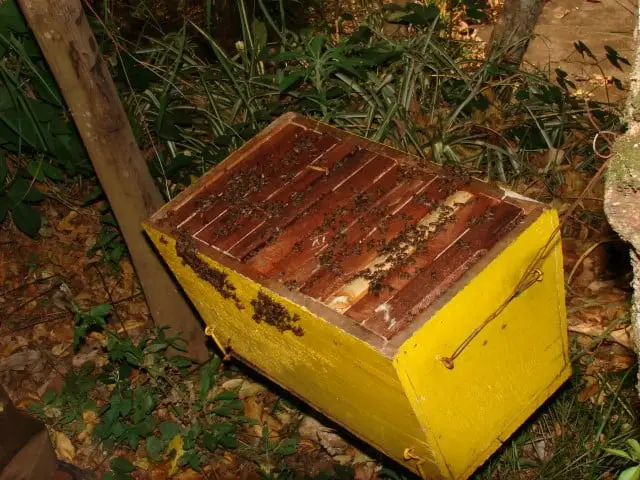Beekeeping with Apis cerana indica
Beekeeping with native bees at Palni Hills, Kodaikanal, Tamil Nadu, India
Guest contribution by Raveendran Kannan

A beekeeper inspecting a Apis cerana colony in a Newton hive
History of beekeeping in Tamil society
Let’s start with some history of honey gathering in Tamil culture and society.
Ancient times:
The traditional Honey Hunter gatherers of Tamil Nadu are well known tribes persons with distinct traits and occupying diverse cultural niche in ancient Tamil society. Their names are not so important and all of them are Tamil speakers with nomadic skills and most inhabited land and jungles adjacent to mountains where flora and fauna thrived. Honey was collected from Apis dorsata, Apis florea and Apis cerana species and sold to society at large.
Vernacular legends paint a good picture of tribes persons gathering nectar from these species and providing honey fo the Tamil society. According to Tamil works of past, the land was classified into five categories with the mountains and adjoing lands producing most honey. The Hunter Gatherer communities exchanged their produce for clothes , salt and oils with other communities of Tamil society.
Not much is known about the role played by hunter gatherer communities during the reign of Mughal emperors , but the first instances of keeping bees in hives for honey was definitely started during colonial era of British India, which also corresponds to period of opening up of forests plantations of timber, coffee and tea.
The Jesuits settled for summer at Kodaikanal 2250 metres above MSL and established the Anglade Institute for training of new priests in to the Order of Jesuits. Among them were noted naturalists who documented flora and fauna around AD 1870.
Rev. Newton who was teaching English, designed the first movable frame hive with 7 frames in the brood, still being used by many beekeepers, hence called Newton Hive
Even now the majority of migratory beekeepers keep Apis cerana in 7 frame Newton hives and work mostly with honey dew from rubber plantations in southern tip of TN, Kanyakumari.
The Imperial entomologist Nietner recorded a colony of Apis cerana in termite mounds with multiple queens
and an estimated population of around 80 000 bees during the early years of the 19th century.
Independent India forms Khadi and Village Industries Commission to be nodal agency for beekeeping development, who through various schemes offer training and distribute hives which often have differing CC distance. The KVIC is still primarily distributing eight frame Newton hives with flat tops that are meant for migratory beekeepers to farmers.
Modern times or The Golden Era:
In the early and mid seventies, the hills were full of banana trees, a special variety called Vrupakshi, which was thriving even at 6.000 ft. These trees provided round the year forage
for bees. Every farmer could keep few hives in his farm and honey could be harvested for six months of the year with once in three weeks harvest intervals. I was exposed to this scene while at school.
In the late seventies we witnessed a severe decline of the banana crop due to a virus bunchy top virus. While the area of banana cultivation was shirinking to one tenth of its past acreage, bee colonies also dwindled.
Contemporary scenario:
A non profit organization by name Palni Hills Conservation Council was set up in 1985 to care for nature at Kodaikanal and conserving flora and fauna. I am one of the founder members.
The council’s primary focus was setting up tree nurseries to supply tree seedlings to reduce demand for wood from forests: Six tree nurseries were set up and beehives were part of the tree nurseries. The idea was to improve upon existing practices to increase honey production. This was a concept for Palani Hills, if not fully back to the Banana cultivation times.
The Palani Hills are a unique area in South India with foot hills plain elevation above MSL 280 Mt. to 600 Mt.
Being cultivated largely with coconut palms where water is available, these areas are good for keeping Apis cerana colonies as coconut trees provide pollen and nectar through the year. Further in adjoing lands with dry conditions Drumstick (Moringa oleiferae) is cultivated in large areas with flowering through for almost 10 months. These two crops offer enough forage for the yellow ecotype or sub variety of cerana bees.
At higher altitudes we find the dark race or hill ecotype of cerana bees, with larger cell size and where forage permits forming colones that easily exceed 10.000 individual bees. These bees are also able to match Apis mellifera in honey production. However, attempts to use them in migratory beekeeping as well as keep them at plains lands have not been successful.
The tree nurseries and beekeeping work were supported by a grant from the Swedish Society for Nature Conservation, Stockholm, Sweden.
They also sent a bee consultant from Uppsala Sweden, Mr. Borje Svensson, who spent time with the project and gave some very good inputs like introducing top bar hives modelled on Kenyan top bar hives.

A wooden top bar hive with tin sheet roof removed
Shortly after his visit in 1994 , the entire Indian subcontinent was affected by Thai Sac Brood Virus and we lost 90 percent of the colonies. In the same year we organised a conference to revive Apis cerana bees from TSBV at Kodaikanal and many from Indian academics and practical beekeepers attended and offered their expertise. We also had the support of Lise Hansted from Danish Beekeepers Federation, Molleveg, Denmark.
From 1996 till 2006 the DBF obtained funds from DANIDA for developing beekeeping in South India, the project was well supported and we kept about 300 colonies in six apiaries with some 12 full time beekeepers attending to the work.
Lise Hansted and Mogens Jensen were sent often to design a village level queen rearing expertise. Mogens Jensen brought with him experience of working with cerana bees in Bangladesh as well.
Finally, the project fabricated Mulderry hives and organized many succesful queen breeding events with some apiaries even progressing in to double grafting of queens, the results were highly impressive indeed:
The colonies in favourable places were able to produce honey in 90 days since the new queen had hatched.

A colony of Apis cerana indica.
The project also published Mogens Jensen’s book on cerana bees in Engllish and Tamil as well.
I was invited and attended two APIMONDIA conferences, in South Africa in 2000 and Ireland in 2006.
The project at the time funded by DANIDA also had a Vietnamese extension with Woven hives prior to coating.

Woven beehives in Vietnam
At VBRD Centre at Hanoi, I met with Hu Yen and Pham Thi on a couple of conferences.
The Vietnamese method of dealing with TSBV was tried and helped us save many colonies.
The project has already run into two phases of three years each and DANIDA withdrew their support when the Indian Admnistration burst their second Atomic Weapon(!) So the project staff were terminated and hives and colonies left with farmers with no one to care for them.
The PHCC, primarily me (I had been the CEO as well as bee project coordinator for almost 15 years) could
not raise funds as done through DBF as I was fully dedicated to conserving and improving bee colonies.
More manmade problems decimating bee colonies
Moreover, the bee colonies at hills and foothill plains were also decimated by the new deadly insecticides
of the imidaclopyrid variety. The situation continues to be bad as many vegetable growers use these poisons that kills cerana as well as other wild bees like Apis florea and Apis dorsata.
During the period 2010 till 2018 there has not been any real extension work with Apis cerana colonies at Palani Hills as climate change has led to severe disruptions in weather patterns that were not conducing for development of cerana bee colonies.
Read more about the reasons for bee extinction.
The primary factor was one of long periods of dry but cloudy weather, favouring development of TSBV and wax moths or unusual rains during spring time.
Furthermore, during the year 2018, the severe cyclonic storm Gaja flattened many coconut palm plantations once a good source of pollen, thus further reducing number of colonies of farmers and beekeepers.
Present work:
I decided to keep bee colonies at other hills and foothill where drought and climate
extremes are moderate and not so severe as in Palani Hills. I have chosen a cluster of hills averaging 1.300 Mt. above MSL and with a solid existing tradition of beekeeping and honey hunting. I have tried to improve their methods and also introduced top bar hives during 2018 and produced queens through grafting on two occassions, which helped a friend and farmer raise some 50 colonies.
During the years of 2017, 2018 and 2019, Lise Hansted and Harinder organised three beekeeping safaris for Danish Beekeepers to visit India and Tamilnadu in particular, just to see that the training initiated through their assistance a decade ago is still producing good results in saving bee colonies as well as producing honey.
Nothing could be done during 2020 due to the corona pandemic and resulting bottom view of mulderry hive with colony lockdowns.
Now there is much interest in keeping bees for honey as all agree that good quality honey improves
immune system in humans.
Furthermore, good unadulterated honey is hard to come by in Indian markets as most are a mixture of wild honey from Apis species plus a liberal amount of rubber honey dew from rubber plantations in neighboring state of Kerala or even Chinese imported honey dews (where unconfirmed reports say aphids that secrete honey dew in large quantities are kept in plants grown in plastic tents where hives are kept and honeydew harvested).
I have put a number of colonies with friends who live on the periphery of the 2nd largest city in Tamilnadu, namely Coimbatore. In this area, due to urban environment there is little or no spraying of pesticides. I always put 3 or 4 colonies out of 10 in top bar hives so as to develop colonies strong enough for queen rearing. The city is surrounded by horseshoe shaped moutains that offer good forest and wild nesting sites for bees. The farmland around the city grows a lot of coconut palms where, the coconut palm is also tapped for sugar thus there is good sugar sap available in some select areas, where due to well fed by palm sap the bees are very calm.
I am planning to start a training program for youngsters who are now just about not sure of any thing as schools and colleges are closed. So far, five people have already shown interest and have ordered hives, so that they can keep their own bees, on their house roofs or in backyards.
The future looks hopeful as even with all the set backs. My tribal friends keep bringing in healthy colonies
that are in good shape and healthy. We have started to colonise empty hives again and hope to bring at least a
couple of top bar hives in to queen rearing soon (by March 2021).
You found this interesting? Stay tuned for more articles!
This is a guest contribution by Mr. Raveendran Kannan.
If you have questions about Apis cerana beekeeping, you can reach him via
Whatsapp: 00 91 9488036184.



